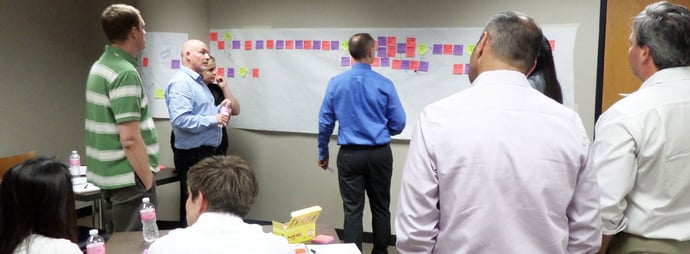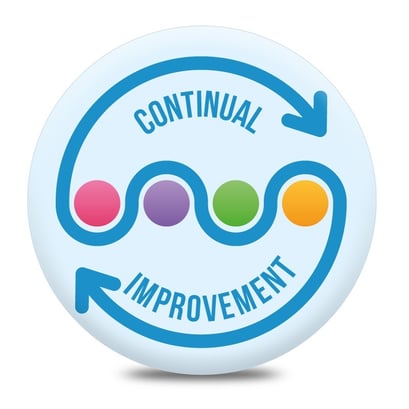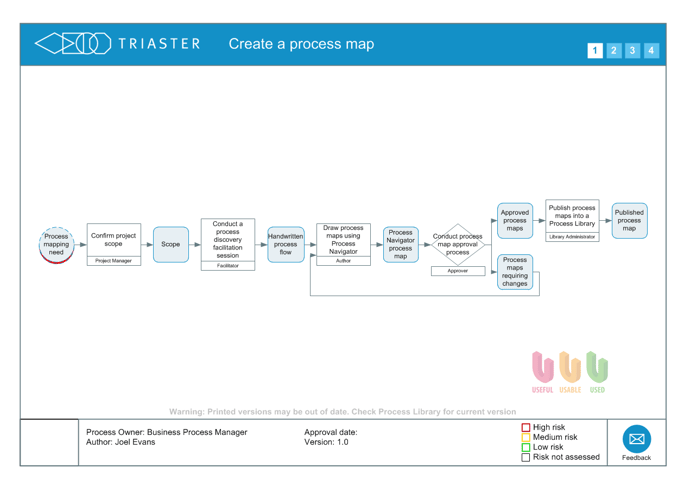Process mapping is the start point for many business journeys and as such it is tempting when asked the question, “What are the benefits of process mapping?” to respond “there are just so many”, but not to explain what they are or how they are achieved. This article sets out to do so.
Contents:
- What is a Process?
- What is Process Mapping?
- What are the Benefits of Process Mapping?
- Getting started with Process Mapping

So firstly, what is process mapping? Indeed what is a process?

What is a Process?
The word 'process' is defined by ISO (the International Organisation for Standardisation) as 'a set of interrelated or interacting activities that transforms inputs into outputs.'
Perhaps a simpler way of putting this is to say, a process is a series of actions or steps taken in order to achieve a particular end. In ISO’s definition, transformation is the key word.
Processes are most easily recognisable in manufacturing, where it is easy to see raw materials (inputs) being transformed into goods (outputs). For example wood (the input) being transformed into furniture (the output).
However anything we do that produces something, is a process. So for example at the moment I am transforming my time into an article.
Generally inputs to a process are outputs of other processes, the exception being at the very beginning of the process - in the example above, the wood – or the very end - in the example above, the furniture. In between there are multiple inter-related processes.
For more on this please read, What is a Process? And who Cares Anyway?
What is Process Mapping?
Process mapping is an exercise to capture all the steps and decisions in a process in diagrammatic form.
So simple!
Wikipedia shows a fun example of this; capturing the process of making breakfast in diagrammatic form as below:

Image credit: Wikipedia
This diagram shows the transformations performed at each level of the cooking breakfast process and illustrates process mapping quite nicely.
There are however, multiple different ways to process map and it is really a question of finding the method and/or software product that will suit your purposes best.
At Triaster, our free process mapping software offers a simple drag and drop toolset, built on the Microsoft Visio platform, and this article explains both how to download it and how to use it: How To Process Map For Free with Process Navigator.
What are the Benefits of Process Mapping?
Another way to ask the question, 'What are the benefits of process mapping?' is, 'Why do process mapping?' And the answers are myriad.
The core reason for process mapping however is that those organisations which perform the transformation of inputs into outputs (their processes) well, generally manage to meet or exceed customer expectation. And those that do it best are invariably the most successful.
Let's explore why:
1. Process Mapping Documents your Business Processes
A process map captures your processes in an easy to understand and easy to follow format. This gives you a blue print for how the process is done. This is sometime called the 'Current State' and sometimes the 'AS-IS'.
In any event process maps present a ‘picture’ of how things are currently done. Once this is in place, a lot of different things can be done with it.
For more on this please read the article: As Is -To Be: The Essential Business Model for Process Improvement.
2. Process Maps Enable Knowledge Transfer
Capturing your processes captures knowledge that would otherwise be lost when employees move on from your organisation. But it is also a great way of sharing best practice ways of doing things throughout your organisation.
One key thing to be done with your process maps is make them available to everyone in the organisation. The more widely they are shared the more benefit they will deliver.
As well as offering free process mapping software, Triaster sells a complete software solution to business process management: Process Library. A Process Library manages and intelligently present all your process maps and supporting policies, forms, and documents. (To view an example Triaster Process Library, please click here.)
This gives everyone in the organisation one place to go to find out how things should be done and quickly find the correct, up-to-date forms and documentations to support their role.
This is a valuable time saver for all staff, but particularly for new starters where process maps can really support the induction process.
More benefit is achieved by making whoever is responsible and whoever is accountable for each activity, clear and visible to the whole organisation - which can easily be captured on your process maps and shared in your Process Library.

3. Agreement of Best Practice is Enabled
With your processes documented, it becomes much easier to agree and adopt consistent best practice. This is usually best done before the process maps are shared via a process library.
With process mapping you can see how things are done differently, in different parts of an organisation and the most efficient way of doing things can be adopted and consistently applied.
For more on this, please read: How to Implement Agreed Ways of Working.
4. Process Maps show your Processes are Compliant
Many industries have their own regulatory bodies whose requirements and regulations must be complied with. Many organisations also want to comply with quality standard such as ISO 9000 and the EFQM excellence model. Showing that your organisation is compliant can be a laborious and time consuming task.
Presenting your auditor with a library of process maps showing that your processes are compliant, can make this a great deal quicker and easier however, especially if the process maps can be easily searched and reported on.
'The use of online interconnected flow charts as the basis of the Business Management System has been successfully established and is easily to navigate', is what Triaster’s ISO 9001:2015 Auditor noted in the ‘Good Practices and General Comments’ section of their report. For the full case study please read: Triaster: Lifting the Lid on the Triaster BMS.
Even before getting to the audit stage process mapping will help to show where work needs to be done to achieve compliance.
Process maps can also protect activities which aren’t immediately obviously value adding, but are essential for reducing risk for example (certainly a value adding activity). For more on this please read: Reconciling Sarbanes-Oxley Compliance and Process Improvement.
5. Process Maps show Opportunities for Improvement
A process should add value – otherwise there is no point in doing it. Sometimes however, especially where there are lots of complex processes being done, in fact some of them aren’t adding value. Or aren’t adding enough value.
This can be hard to spot, but process mapping captures what is actually happening; who is involved, where information, data, materials are flowing and most importantly the handover points between processes, departments and supply chains.
It is often in the capture phase – the process discovery workshops - that opportunities for improvement are spotted. It can be found that processes are being duplicated in differing parts of the organisation, or something is being produced by one process, which isn’t being used by any other.
Triaster have developed a Noun-Verb methodology of process mapping, which also really helps to highlight where value isn’t being added.
If not spotted in the capture phase, opportunities for improvement often become obvious once the As-Is picture of your organisation is completed. Especially if the end-to end process is captured, showing the big picture.
If your process mapping toolset also enables you to capture data, the opportunities for improvements are even easier to spot and quantify. Sometimes the biggest efficiency gains, for example, can be achieved by improving a process that is repeated many times, by just a small amount.

6. Process mapping supports Continuous Improvement
Given that no organisation ever reaches perfection, all organisations need to continually improve. It can be exhausting and demoralising for employees however, if things are continually changing.
Process mapping can really help with this because with reference to the AS-IS process maps, To-Be options can be tried out before making the changes.
The Triaster Process Library also enables the data and system impacts to be modelled, so that these too are fully understood and costed before changes are made and implemented.
Getting started with Process Mapping
As mentioned above, Triaster offers free process mapping software which offers simple drag and drop functionality. Downloading this is the ideal place to get started with process mapping and benefitting from all it can deliver.
Related Articles:
How To Process Map For Free with Process Navigator.
What is the Noun-verb methodology of Process Mapping?
What is a Process? And who Cares Anyway?
Related White Papers:
The Ultimate Guide to Business Process Mapping
This is an updated and refreshed version of an article originally written in 2016.
Written by Emma Harris
Emma was Operations Director for Triaster for nearly 20 years, during which time as well as learning and perfecting her BPM and process improvement skills, she honed her inbound marketing expertise. She now runs D2e - Designed to engage - which designs and develops bespoke, engaging, HubSpot CMS websites, that help your entire company to grow and scale. She is delighted to still be delivering Triaster's marketing, whilst also helping other companies turn their websites into their hardest working asset.


